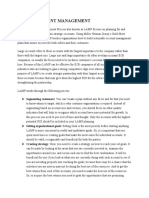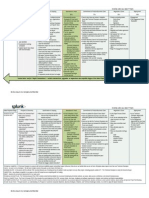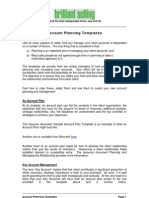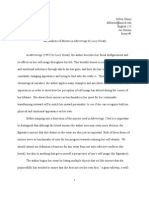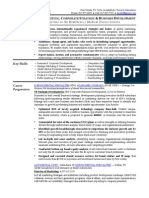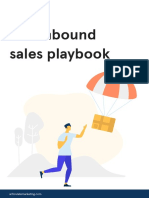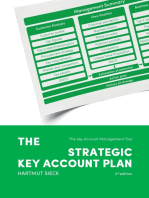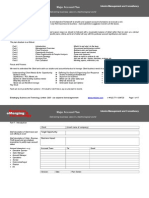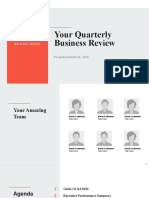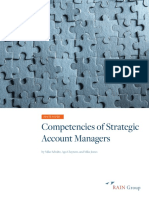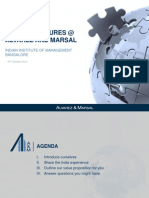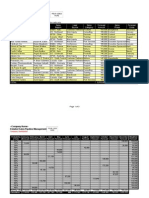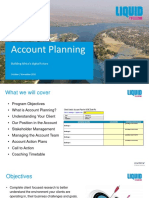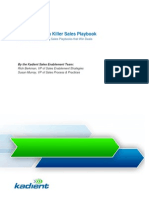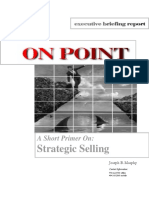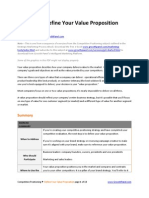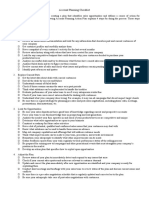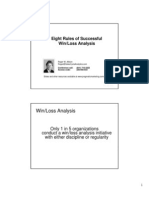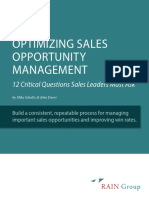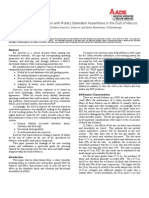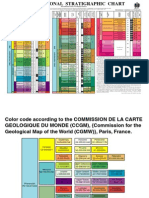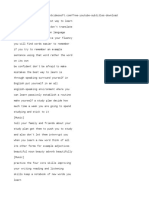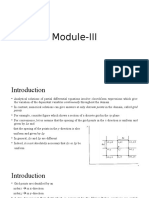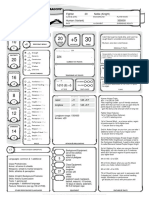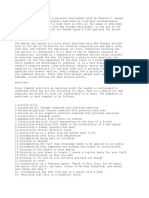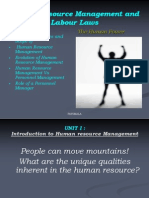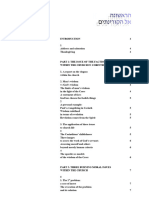Strategic Account Plan E Book
Strategic Account Plan E Book
Uploaded by
Ionut StiujCopyright:
Available Formats
Strategic Account Plan E Book
Strategic Account Plan E Book
Uploaded by
Ionut StiujCopyright
Available Formats
Share this document
Did you find this document useful?
Is this content inappropriate?
Copyright:
Available Formats
Strategic Account Plan E Book
Strategic Account Plan E Book
Uploaded by
Ionut StiujCopyright:
Available Formats
X.
Manage Account Relationships
Account
I. Develop Customer Profile
IX. II. Analyze Development Organization Coordinate Relationships Contiuous Action Roles and Improvement Business Plans responsibilities Challenges Account History
Measure and Assess Improvements Perceptions / Levers
VIII. Develop Account Strategy
Value -Added Competitive Differentiation SMART Objectives Executive Relationships
Most important requirements Key needs Analysis of Potential Leverageable Strenghts
III. Identify Strategic Requirements
10-Step Strategic Account Management E-Book
Decision Past Process Performance
VII. Establish Objectives
Business and strategies
Buying Habits
IV.Analyze New Opportunities
VI. Analyze Competitors
V. Map Decision Process
Copyright 2009 by Global Partners Inc. All rights reserved
Introduction
Overview
This sample guide to Strategic Account Management is based on a compilation of best practices identified in benchmark research and numerous client cases. It is designed to demonstrate the outcome of strategic account teams following our 10-step process for formulating and implementing a strategic account plan.
The following tips should help in the strategic account management process: Read the entire planning guide to filling it in, as it is designed for learning the SAM process Be flexible - adapt the questions and forms to fit the business and the accounts needs. Follow the 10 step process in an iterative way, constantly checking back to make sure the requirements and strategy are consistent and logical. Remember, this is a continuous process. Since most of the information is dynamic, the plans should be reviewed and revised frequently, and a major comprehensive plan should be done once or twice per year. The goal of this comprehensive guide is to provide you with detailed analytical tools. Once the Account Planning process is familiar, a shorter Account Plan may become a more efficient document for your regular use. With large accounts, each representative should contribute the information from their respective areas of this account plan to build a combined document. In most cases, you will use this document to record and plan your particular activities.
X. Manage Account Relationships
Account
I. Develop Customer Profile
IX. II. Analyze Development Organization Coordinate Relationships Contiuous Action Roles and Improvement Business Plans responsibilities Challenges Account History
Measure and Assess Improvements Perceptions / Levers
VIII. Develop Account Strategy
Value -Added Competitive Differentiation SMART Objectives Executive Relationships
Most important requirements Key needs Analysis of Potential Leverageable Strenghts
III. Identify Strategic Requirements
Decision Past Process Performance
VII. Establish Objectives
Business and strategies
Buying Habits
IV.Analyze New Opportunities
VI. Analyze Competitors
V. Map Decision Process
Copyright 2009 by Global Partners Inc. All rights reserved
I. Develop Customer Profile
Account Name:
I.
Volvo Car Corporation Gothenburg Car-Manufacturer Cars Gothenburg, Ghent, Udevalla
Location: Description: Products and Specialities Facilities:
A. Customer Objectives
1. Long-Term Vision and Goals: Become a totally customer-oriented Company Secure Premium Brand Status - Improve perceived quality - Improve overall image Focus on brand values - Safety, personnel security - Family, environment Emotional brand perception Environment Become #1 at JD Power Customer Satisfaction Sales to increase to 600.000 p.a. Introduce new small car, based on Safety Concept Design (SCC) Increase profitability Decrease development time of new vehicle to 24 months 2. Specific Short-Term Objectives Focus on high Quality program initiative. Launch of the XB-90 Introduction of Bi-Fuel vehicles during 2012 Introduction of low-emission engines (Noise problems) during 2015.
The Strategic approach to managing accounts requires you to become customer-focused. There must be a commitment to understanding the customers business as an insider and to providing value-added solutions throughout its organization. Think about the account to understand the CEOs vision, the strategies, its organization and their objectives.
3. What are their strategies to achieve these objectives? Offer a product range which covers all car segments (see BMW, Audi, Mercedes) Focus on Total Quality & Environment Stay Best in Class on safety Emotional customer oriented styling concepts 4. Financial Position Revenues Profits EBIT /share Share price growth
Growths Bond rating Copyright 2009 by Global Partners Inc. All rights reserved
I. Develop Customer Profile
I.
B. Organization
1.a. Ownership of account Volvo Car Corporation 1.b. Governance and structure Volvo Car Corporation 1.c. Alliances with other organizations 2. Organization Chart
Anders Nystrm Vehicle Purchasing Purchasing Director Anna Holmer Purchasing Strategy Office Vivianne Crothers Administrative Assistant
Understanding the formal organizational structure is an important starting point. However, as we will see later the 'informal' network of decision-makers and influencers is far more influential on the customer's actual buying process.
Ford / PAG 1.d. Major Market Areas Volvo Car Corporation 1.e. Explain primary reasons why their customers buy from this organization
Anders Rnnberg Chassis & Powertrain Installation Albie van Bul Interior Anders Sundin Parts & Accesories
L-G Jnsson Electrical Tomas Haraldsson Exterior
Reasons: Safe high quality cars, with modern design for customers with different life-styles
Copyright 2009 by Global Partners Inc. All rights reserved
II. Analyze relationships
II.
A. History
1. Initial contacts and evolution of your business Who are all the contacts in the account? Which ones have formal authority, influence, both or neither?
Think through your current relationship with the account, focusing on the account history, present contract performance and perceptions of your company within the organization.
Do we have 'Coaches', contacts who will provide information and advice to help us win? 2. Describe the breadth of your present account coverage How present are we in all key locations? What is our frequency of contact? Where are the gaps?
Copyright 2009 by Global Partners Inc. All rights reserved
II. Analyze relationships (cont.)
B. KEY CUSTOMER CONTACTS AND THEIR CONCERNS Under each category, select one descriptor from the appropriate column:
II.
Decision-Making Role D = Decision Maker E = Evaluator A = Approver
The following table asks you to think through all of the important contacts at the customer organization. This will become a key document that all team members should have and update regularly. It will be especially critical during the strategy and planning phases. List contacts in rank order of importance and influence in the decision-making process for each department (use your attached organization chart). Under each category, select one descriptor from the appropriate column.
Attitude Toward Us ++ = Key Supporter + 0 = Ally = Neutral = Non-Supporter
I = Influencer
Extent of Contact + = high = = average - = infrequent
Leadership + = Strong = = Moderate - = Weak
Under Most Important Concerns include such criteria as price, competence, reliablity, experience, responsiveness etc.
Copyright 2009 by Global Partners Inc. All rights reserved
II. Analyze relationships (cont.)
II.
Department Headquarters / Admin Purchasing
Key Account Contact Name: S. Armstrong Title: Sen. Vice Pres. Name: A. Nystrm Title: Purchasing Dir. Name: A. Van Bul Title: Purch. Mng. Int. Name: S. Pettersson Title: Head R+D Interior Name: P. Palmqvist Title: Vice Dir. R+D Interior Name: T. Werner Title: Interior P2X
DecisionMaking Role D
Attitiude toward Us 0
Most Important Concerns Price, competence, reliability, E-business Price, reliability, emerging markets Price, Future Supplier Base, reliability Virtual engineering, competence, R&D
Expectations of Us Good Price / Quality balance Good Price / Quality balance Good Price / Quality balance, System Approach Competence, Quality, Innovative Solutions, Smooth P1X/P28 introduction New innovations, competence New innovations, development support, know-how
Purchasing
Purchasing
++
How wide and deep are the relationships with the account? Are we connected to senior managers and decision-makers or mostly to technical people and procurement? How do we use our current network to establish new, higherlevel relationships? How do we discover the concerns and expectations of key contacts?
Technical
I/A
Technical
++
Competence, Lean deployment, virtual engineering Competence, Price, Know-How, technical support
Technical
I/D
Copyright 2009 by Global Partners Inc. All rights reserved
II. Analyze relationships (cont.)
C. Perceptions and Levers
1. Relationship Swot Analysis
II.
Strengths - Competence in thermal management - Technical and commercial organisation at Volvo with good engineering and CAD support - Pro-active and innovative solution provider - Reliable partnership - Good product portfolio - Financial strengths of our Group Weaknesses - Manufacturing skills - Unclear manufacturing strategy - Project management resources & capabilities - Cash flow from operations - Risk management - Product development - Unreliable calculations from Rieter Operations Threats - Joint Interior approach could lead us to 2nd tier position? - Failing to keep pace with OEMs pricing demands - Lose single source position for acoustics and carpets
Identify the unique strengths that you can leverage to beat the competition. Remember to identify those that the customer would agree are unique strengths. Be honest about your most critical weaknesses. Which ones will your competitors attack? How will you use your Strengths to address the Opportunities and Threats?
Opportunities - X70-Face lift , Luggage compartment and X70 successor 200x - Increase market share through sales of under floor systems - Joint approach with tier 1 to offer Integrated Interior concept - Involve Innovation Institute for advances engineering and styling
Comments We need a new manufacturing strategy and clearer costing methods (before and after calculations) in order to get more transparancy in the overall profitability level. Also more control is needed in the follow-up of the internal plant-results. Copyright 2009 by Global Partners Inc. All rights reserved
III. Identify Strategic Requirements
A B. Contracts History and Total Sales
Sales DEPARTMENT Mil $ per annum SALES DESCRIPTION OF CONTRACTS
III.
Other TOTAL SALES Last year
Define the customer's buying history, broken down by division where possible, showing total business and share of budget. Clarify requirements and your expectation of the customers future needs.
Previous year Year before
Percent of Plan Year-to-Date
C. Most important requirements
1. What supplier capabilities does this account rate very highly?
- Cost
- Quality - Development and acoustical know-how support
Copyright 2009 by Global Partners Inc. All rights reserved
III. Identify Strategic Requirements
2. What issues or concerns are expressed to all vendors? More outsourcing for OEM to System-Suppliers, resulting in more responsibility and/or higher turnover, for fewer suppliers. (more price pressure)
III.
Continuous cost reduction Increased quality demands Reduce weight 3. What are the current and future needs of each department? ANTICIPATED FUTURE NEEDS and DELIGHT FACTORS Dept. Purchasing Dept. Interior engineering More responsibility to suppliers, less risk for OEM (Example T.A. discussions and sequencing responsibilities) Weight reduction to reduce fuel consumption. Increasing demands on comfort (acoustic improvement) Improved craftsmanship Further product development and engineering services
Describe the customer's basic requirements as expressed to all suppliers. Which needs are currently not being met by any supplier? What are the likely needs that the customer will have in the future? What would 'delight the customer'?
Dept. Acoustics Dept. Quality / Production
Higher demands on interior quietness < 60 ppm six sigma
Copyright 2009 by Global Partners Inc. All rights reserved
IV. Analyze New Opportunities
A. Leverageable strengths
How will you leverage your company and your resources to find new opportunities? Acoustical Know-How
IV.
Innovative System-Solutions Full System approach and support in technical development (Swedish Team)
In the earlier sections, you analyzed the customer, their needs and your competitors strengths as well as your own. It is important now to review your analysis and identify those areas where you should focus your efforts. Review your key findings from previous sections Then identify where you think your strengths can be leveraged to serve the customer and its requirements, where your weaknesses must be overcome and where you may be able to exploit previously untapped opportunities to provide unique value.
Involve R&D in advanced engineering project
B. Exposures
1. What shortcomings do you need to overcome, such as large gaps between current business and potential business or need for unique capabilities? Improve project management Improve lean manufacturing process Increase supplies out of emerging markets 2. What mistakes have been made in the past that needs to be corrected? What complaints are still outstanding?
Our cost estimates are not transparent, which leads to wrong pricing of products. This again results in life time difficulties as far as economics to the customers and return to us is concerned! Copyright 2009 by Global Partners Inc. All rights reserved
V. Map Decision Process
A. Decision-Making Process
1. Describe the formal decision-making process: Common platforms: Global council from Jaguar, Volvo and Ford of America. Unique Platforms: See decision making role. Cross functional team is meeting together, in order to extract a decision proposal for supplier nomination to head of Purchasing and R+D
Outline the key criteria and most important requirements in the organizations decisionmaking process. On the next page, identify how and by whom the decision will be made, and what other factors might influence the process.
V.
2. Describe the informal decision-making pattern: Informal decision making through people who are not officially cross functional team members (e.g. Peter P, Stefan P, ) 3. Map the Decision-Making Process: Prerequisites. Concept proposal incl. offer. Evaluate proposal with customer. Target price setting. Negotiations. Agreement. Copyright 2009 by Global Partners Inc. All rights reserved
V. Map Decision Process
B. Decision Process (By Major Department)
Process Description Include Milestones and Buying Habits (e.g. tenders, administrative involvement and outside influence) Recommend potential suppliers, Nominate potential suppliers, Nominate potential supplier with common view Ford/VCC, Decision at VCC. Strategic sourcing in order to achieve a supplier base Recommend potential suppliers, Nominate potential suppliers, Nominate potential supplier with common view Ford/VCC, Decision at VCC. Cost driven purchase manager (low cost countries etc) Recommend potential suppliers, Nominate potential suppliers, Nominate potential supplier with common view Ford/VCC, Decision at VCC. Critical individual and has problems to take decisions Typical Evaluation Criteria Key Players Weighting Factors Outside Pressures
Dept.
Purchasing
A. v. Boulet
Cost Mfg. Logistics Commercial
20% 10% 10% 5%
Global Council
Purchasing
P. Anders
Cost Mfg. Logistics Commercial
20% 10% 10% 5%
Global Council
Purchasing
A. Eriksson
Cost Mfg. Logistics Commercial
20% 10% 10% 5%
Internal VCC and Peter Anders
Copyright 2009 by Global Partners Inc. All rights reserved
VI. Analyze Competitors
A. The Competition From The Customers Perspective
Accounts Most Important Requirements (MIRs) in order of priority 1. Cost
VI.
Account Current Ranking (1 to 5,5 = Best) and Comments about the Competition Weight 40 20 20 20 100% Your Company 2 4 5 3 320 Competitor A 3 3 3 3 300 Competitior B 2 2 2 4 240 Competitior C 2 4 2 4 280
Your Benefits vs. Competition 1. Local Team 2. Accoustical Know-How and support 3. R.U.L. Concept Proposal
2. Technical Support 3. Acoustics
Identify and assess your major competitors at this account and particularly competitors for each major department opportunity.
4. Quality Totals of Weighted Scores Current Choice:
Why? Concept Proposal RUL Technical Support on site
Strategies to Overcome Major Competitors Advantages: 1. Productions Transfer to Emerging Markets 2. Six-Sigma
* Raw Score: 1-5 * Weighted Score: (1-5) x weight
Copyright 2009 by Global Partners Inc. All rights reserved
VI. Analyze Competitors (cont.)
B. A FaceOff With Leading Competitor
Marketing Your Company: Key Competitor: Observations, Explanations and Comments
Result is based on current situation. But situation for competitor is improving Result is based on current situation. But situation for competitor is improving Result is based on current situation. But situation for competitor is improving
Selling
Technology
Quality
Service
Financial
C. The Competitor From A Local Perspective
Marketing Strategy: How does the competition measure succes at the local level? Revenue? Share of Market? Profit? Other? Share of Market Selling Strategy: Are trying to get into Volvo with support of Ford in the gloabal council Strenghts as the Customer sees them: Technical support
Weaknesses as the customer sees them: No good technical concept / innovation Financially weak
Strategies to Position Against this Competitor: Improve relationship with parent, so that our position in the global council improves
Copyright 2009 by Global Partners Inc. All rights reserved
VII. Establish Objectives
A. Business Objectives
1. Specify for your Business Objectives in terms of Contract Sales by department. Specify business volumes and expected profits where possible.
Departments Technical TotalSales in US$ Profits % Comments
VII.
Dept.
RATIO
50% of savings for us
Total Revenue Identified
Average Profit %
Consider the long-term results first and then, set must accomplish objectives for the shortterm. The best objectives are quantifiable: achieve xamount $ in new business in September, gain 75% of budget by the end of October, or grow the business by 25% by the year-end. Written correctly, the results to be achieved will be S.M.A.R.T.: Specific, Measurable, Achievable, Realistic and Timely. They should relate to the customers Most Important Requirements.
Total Personal Target for year: Percent of your target:
2. How can your business objectives support customer goals and objectives from Section I of this guide?
B. Relationship Objectives
Individual Departments Purchasing Technical / Acoustic Quality Objectives Offer competitive System-approach Support Volvo vie IDEA Institute In the initial stage of a new project -> 6-sigma
C. Special Programmes
What special programs could you initiate to open up new opportunities or cooperate on new ventures? What other objectives will help to advance your service activities? Copyright 2009 by Global Partners Inc. All rights reserved
VIII. Develop Account Strategy
A. Value-Added Competitive Differentiation
1. How will you demonstrate your value-added capabilities to differentiate yourselves successfully?
VIII.
Offer to build demonstration car to show capabilities Professional Presentations Simulation Projects 2. What will be the critical success factors in implementing the strategy? Resources and MONEY
Your strategy will answer the question: How will I differentiate my offerings from the competition and win more contracts at the account?
3. How will you improve economic justification so as to demonstrate a better value than your competition? Smart solutions for a lower price
4. How can you minimize the costs of doing business with your company? Transfer parts to emerging markets Implement automated equipment for new projects if feasible financially i order to achieve a low percentage to sales labour content. Propose alternative specifications, still fulfilling customers technical requirements.
Copyright 2009 by Global Partners Inc. All rights reserved
IX. Coordinate Action Plans
WHAT actions need to be taken to implement the strategy? WHO is responsible for each of these actions? Where can you delegate? WHEN should each action step take place? In what order? HOW will you accomplish each action? HOW will you determine if each action has been accomplished successfully? WHAT resources are required? Your plans must be proactivley tracked and evaluated on a regular basis to ensure that they are on target and to assure yourself that there have been no changes in the external or internal environment that require revised strategies or implemenation plans.
IX.
Once the strategies have been determined, your most important role is selecting specific tasks to implement. The plans are a critical component of the Key Account Process. Key questions to continually ask when devising the action plans are:
A. Tactics: Tasks, Roles and Responsibilities & Timing
Use the matrix below to help think through your roles and responsibilities and action plans. Consider needs analyses, long-range planning, support etc. Note that the most effective planning documents are also used to track progress on a regular basis. Recording actual accomplishments becomes a critical part of Account Plan implementation. Planned Task (What?) Responsibility (Who?) Timing of Critical Steps (When?) Resource Needs (e.g. budget) Date Completed
Copyright 2009 by Global Partners Inc. All rights reserved
X. Manage Account Relationships
A. Advance Partnerships
X.
C. Customer Satisfaction
1. How will you gauge your progress in customer satisfaction (e.g. surveys, interviews, face-to-face meetins or executive meetings, etc.)?
What are the top two initiatives your company could take to improve its level of account partnering with thought-leading executives? 1. 2.
2. How will you provide customer feedback and work to improve your own performance?
Developing a longterm mutually beneficial partnership requires careful key development and planning for implementation, but it also requires ongoing efforts that continually nurture and advance the relationship.
B. Account Development
1. What activities would bring your company perception to a new level e.g. sponsored research, joint development?
2. Which departments would benefit the most?
3. Where would your company get the best return for its efforts?
Copyright 2009 by Global Partners Inc. All rights reserved
About Global Partners, Inc.
Global Partners Inc. is an international consulting and management development firm. Our Vision is to become a trusted partner to Clients, inspiring them to improve their performance to its highest levels. Our Mission is to support and enable our client partners to achieve their highest sustainable performance, by developing the capabilities of individuals, cross-cultural teams and organizations with innovative programs and by leveraging our executive experience.
Copyright 2009 by Global Partners Inc. All rights reserved
Some of Our Clients
Copyright 2009 by Global Partners Inc. All rights reserved
For Further Information regarding Strategic Selling and Account Management
Contact us at Global Partners, Inc. One Broadway Cambridge, MA 02142 USA Office: 1 (617) 401-2510 Fax: 1 (617) 401-3604 info@globalpartnersinc.com
Copyright 2009 by Global Partners Inc. All rights reserved
You might also like
- Large Account ManagementDocument3 pagesLarge Account ManagementJharna75% (4)
- Enterprise Sales Guide: Sales Process PlaybookDocument14 pagesEnterprise Sales Guide: Sales Process PlaybookWork-Bench93% (15)
- Accenture Account PlanDocument21 pagesAccenture Account PlanVarun KaushalNo ratings yet
- Enterprise Sales Guide: Customer Evaluation DocumentDocument9 pagesEnterprise Sales Guide: Customer Evaluation DocumentWork-Bench100% (8)
- Sales Playbook - Sales Tool (PDF) - 2012 PDFDocument2 pagesSales Playbook - Sales Tool (PDF) - 2012 PDFMarcus Panasan100% (3)
- Account Planning TemplatesDocument5 pagesAccount Planning Templatesgoran_sandevNo ratings yet
- An Analysis of Mirrors in Mirrorings by Lucy GrealyDocument4 pagesAn Analysis of Mirrors in Mirrorings by Lucy GrealyDillon Horne100% (1)
- Sample Account Planning Template: Developed by Revegy, IncDocument13 pagesSample Account Planning Template: Developed by Revegy, IncAnna Shar100% (1)
- Value Based SellingDocument48 pagesValue Based SellingShubhankar MathurNo ratings yet
- Strategyand Commercial Excellence ProgramsDocument16 pagesStrategyand Commercial Excellence Programspulsar77No ratings yet
- TOPO Sales Process DesignDocument19 pagesTOPO Sales Process DesignMax de Freitas100% (2)
- VP Director Corporate Strategy Business Development in Dallas FT Worth TX Resume Helith SoferDocument3 pagesVP Director Corporate Strategy Business Development in Dallas FT Worth TX Resume Helith SoferHelithSoferNo ratings yet
- Strategy Map Templates Version 10Document22 pagesStrategy Map Templates Version 10vidit1100% (2)
- Blue Sheet AnalysisDocument5 pagesBlue Sheet AnalysisPrarthana Gulati100% (1)
- Gartner b2b Buyer's JourneyDocument7 pagesGartner b2b Buyer's JourneySangram SabatNo ratings yet
- Ideal Customer Profile FrameworkDocument9 pagesIdeal Customer Profile FrameworktatagalgoNo ratings yet
- The Inbound Sales Playbook - Interactive PDF by Articulate MarketingDocument23 pagesThe Inbound Sales Playbook - Interactive PDF by Articulate MarketingSacha BismuthNo ratings yet
- Angles and DirectionsDocument24 pagesAngles and DirectionsSera Lee100% (1)
- The Strategic Key Account Plan: The Key Account Management Tool! Customer Analysis + Business Analysis = Account StrategyFrom EverandThe Strategic Key Account Plan: The Key Account Management Tool! Customer Analysis + Business Analysis = Account StrategyNo ratings yet
- Major Account PlanDocument17 pagesMajor Account PlanIchsanul Anam100% (2)
- Account PlanningDocument27 pagesAccount PlanningNatasha Kolykhalova100% (1)
- Template Strategic Sales PlanDocument6 pagesTemplate Strategic Sales Plansurfkaju100% (2)
- Eades Solution Selling ConferenceDocument35 pagesEades Solution Selling ConferencekberbertNo ratings yet
- QBR TemplateDocument23 pagesQBR Templatepapit0100% (1)
- Strategic Account ManagementDocument27 pagesStrategic Account ManagementSreekanth Reddy NarapareddyNo ratings yet
- Sales & Key Account ManagementDocument46 pagesSales & Key Account Managementamitmahar100% (3)
- Competencies of Strategic Account ManagersDocument18 pagesCompetencies of Strategic Account Managerss.chabot4130100% (2)
- Adopting Consultative Selling Best Practices GuideDocument15 pagesAdopting Consultative Selling Best Practices GuideDemand MetricNo ratings yet
- $$Alvarez&Marsal PDFDocument16 pages$$Alvarez&Marsal PDFSourav DasNo ratings yet
- Blue Sheet - Barclays PuneDocument11 pagesBlue Sheet - Barclays PuneShipra SinghNo ratings yet
- Converged Systems Sales PlaybookDocument12 pagesConverged Systems Sales PlaybookPeter Stone100% (3)
- Ebook - CSM From The Trenches - Customer Success Best Practices (By ClientSucces)Document11 pagesEbook - CSM From The Trenches - Customer Success Best Practices (By ClientSucces)Gustavo Lomba100% (1)
- ANA Customer Engagement BPG PDFDocument45 pagesANA Customer Engagement BPG PDFDemand Metric100% (1)
- Consultative Selling Process OverviewDocument11 pagesConsultative Selling Process Overviewocto widodo100% (1)
- Funnel and Opportunity ManagementDocument29 pagesFunnel and Opportunity Managementmanahuja100% (1)
- GTM Strategy ProposalDocument2 pagesGTM Strategy ProposalNikita GulguleNo ratings yet
- The Evolution of B2B Sales: Trends and TransformationsDocument14 pagesThe Evolution of B2B Sales: Trends and TransformationsSayed Faraz Ali ShahNo ratings yet
- MarketingCampaign DV Sales BattlecardDocument2 pagesMarketingCampaign DV Sales BattlecardAhmad FarrahNo ratings yet
- Sales Pipeline Funnel Management Report TemplateDocument3 pagesSales Pipeline Funnel Management Report TemplatememmabelfortNo ratings yet
- Salesplaybook v2-0 PDFDocument28 pagesSalesplaybook v2-0 PDFJohn PatlolNo ratings yet
- BAIN BRIEF Creating An Adaptive Go To Market SystemDocument12 pagesBAIN BRIEF Creating An Adaptive Go To Market SystemMeera Mohan100% (3)
- How To Unlock Growth in The Largest AccountsDocument6 pagesHow To Unlock Growth in The Largest AccountsAsh HassanNo ratings yet
- Sales Playbook Template 92Document28 pagesSales Playbook Template 92Niamh Malone100% (1)
- Account Planning MD311016Document43 pagesAccount Planning MD311016Stanley100% (1)
- How To Create Killer Sales Playbooks GuideDocument14 pagesHow To Create Killer Sales Playbooks GuideLeonie Newbury100% (1)
- Strategic Selling Primer and Notes1Document23 pagesStrategic Selling Primer and Notes1Shekhar Teny100% (1)
- The B2B Executive Playbook: Achieving Sustainable, Predictable, Profitable GrowthDocument21 pagesThe B2B Executive Playbook: Achieving Sustainable, Predictable, Profitable GrowthSasi KumarNo ratings yet
- Digital Value Creation Accross The Deal CycleDocument13 pagesDigital Value Creation Accross The Deal CycleTrần Phương Thuý100% (1)
- Go-To-Market Strategies Product Launch ChecklistDocument6 pagesGo-To-Market Strategies Product Launch ChecklistFadi100% (3)
- Buyer Enablement Win More b2b Sales DealsDocument17 pagesBuyer Enablement Win More b2b Sales DealsRohit KaulNo ratings yet
- Security Sales Playbook.eDocument4 pagesSecurity Sales Playbook.eWaheeb YaqubNo ratings yet
- Define Your Value PropositionDocument13 pagesDefine Your Value Propositionwww.GrowthPanel.com100% (8)
- EY Customer and Growth Capabilities Customer ExperienceDocument18 pagesEY Customer and Growth Capabilities Customer ExperiencearkadiiNo ratings yet
- Account Planning ChecklistDocument1 pageAccount Planning ChecklistGhassan QutobNo ratings yet
- AKSH People TransformationDocument12 pagesAKSH People TransformationjayadevmNo ratings yet
- Eight Rules of Win Loss AnalysisDocument12 pagesEight Rules of Win Loss AnalysisAnshulNo ratings yet
- Optimizing Sales Opportunity Management: 12 Critical Questions Sales Leaders Must AskDocument16 pagesOptimizing Sales Opportunity Management: 12 Critical Questions Sales Leaders Must AskMarcelo Partes de OliveiraNo ratings yet
- B2B 2 Page Cheat Sheet:NotesDocument2 pagesB2B 2 Page Cheat Sheet:NotesGermaineNo ratings yet
- Strategic Account Business PlanDocument5 pagesStrategic Account Business PlanKiếnĐenNo ratings yet
- What Module SPIN Selling FrameworkDocument47 pagesWhat Module SPIN Selling FrameworktinornitNo ratings yet
- NPF Driver Problem in Windows 7 - Wireshark Q&ADocument3 pagesNPF Driver Problem in Windows 7 - Wireshark Q&AIonut StiujNo ratings yet
- Analysis of PDC Bit Selection With Rotary Steerable Assemblies in The Gulf of MexicoDocument11 pagesAnalysis of PDC Bit Selection With Rotary Steerable Assemblies in The Gulf of MexicoJasim BashirNo ratings yet
- MacBook 13inch Aluminum Late2008Document88 pagesMacBook 13inch Aluminum Late2008Ionut StiujNo ratings yet
- Chronostrat Scale EuropeDocument2 pagesChronostrat Scale EuropeIonut Stiuj100% (2)
- Randomvariablesandprobdistributions Practice Exercises PDFDocument3 pagesRandomvariablesandprobdistributions Practice Exercises PDFPhantomsuplexNo ratings yet
- SubtitlesDocument4 pagesSubtitlesHoucine ZnikerNo ratings yet
- Ayurvedic Medicine and Public Perception Its Potential Benefits, Limitations, and The Need For Evidence-Based PracticeDocument3 pagesAyurvedic Medicine and Public Perception Its Potential Benefits, Limitations, and The Need For Evidence-Based PracticeVrinda TrehanNo ratings yet
- How To Have A Healthier Christmas With Bodyslims EbookDocument21 pagesHow To Have A Healthier Christmas With Bodyslims Ebook1Moggs1No ratings yet
- Natal DLP RightTriangleSimilarityDocument7 pagesNatal DLP RightTriangleSimilarityakosidar2000No ratings yet
- CFD Module-IIIDocument53 pagesCFD Module-IIIAbhishek BeraNo ratings yet
- Grade 7 Compiled Hy-Sm 2023-24 (1) '"Document152 pagesGrade 7 Compiled Hy-Sm 2023-24 (1) '"abhay19.329No ratings yet
- My Uncle CompleteDocument120 pagesMy Uncle Completeaminaibrahimdauda330No ratings yet
- Lesson Plan DetailedDocument10 pagesLesson Plan DetailedDebby Bantug100% (1)
- Fighter 20 Noble (Knight) Human (Variant) 355000Document3 pagesFighter 20 Noble (Knight) Human (Variant) 355000johncena1298No ratings yet
- Using Management Consulting ServicesDocument4 pagesUsing Management Consulting Servicesstennes1No ratings yet
- Esoteric and Exoteric AstrologyDocument6 pagesEsoteric and Exoteric Astrologydvrao_chowdary100% (1)
- Nelson Information Technology VCE Units 1 & 2: Apply Your Knowledge AnswersDocument3 pagesNelson Information Technology VCE Units 1 & 2: Apply Your Knowledge AnswersVachara PeansupapNo ratings yet
- Assignment No. 8: Questions To AnswerDocument2 pagesAssignment No. 8: Questions To AnswerRolly CabuyaoNo ratings yet
- Master Key SystemDocument2 pagesMaster Key SystemBillionaire123No ratings yet
- The Heston Model: Hui Gong, UCLDocument12 pagesThe Heston Model: Hui Gong, UCLharish dassNo ratings yet
- Baby NamesDocument10 pagesBaby Nameselasu85No ratings yet
- Vastu Shastra by Instituteof Vedic AstrologyDocument13 pagesVastu Shastra by Instituteof Vedic AstrologyInstitute Of Vadic Astrology100% (1)
- HRM and Labour LawsDocument24 pagesHRM and Labour LawsDipti TyagiNo ratings yet
- Describing PeopleDocument2 pagesDescribing PeopleMihaelaNo ratings yet
- La Suerte Cigar and Cigarette FactoryDocument18 pagesLa Suerte Cigar and Cigarette FactoryColBenjaminAsiddaoNo ratings yet
- Unit 7Document6 pagesUnit 7Yep YupNo ratings yet
- DataStudio Software Single User Manual CI 6870GDocument20 pagesDataStudio Software Single User Manual CI 6870GOctavia WestNo ratings yet
- BG 02 Geeta - Sankhya YogaDocument103 pagesBG 02 Geeta - Sankhya Yogasrivatsa100% (1)
- Start MeDocument22 pagesStart MeirmaarmiyahNo ratings yet
- 1 CorinthiansDocument18 pages1 CorinthianspastoroldaNo ratings yet
- William F. Brewer & Edward H. Lichtenstein - Event Schemas, Story Schemas, and Story Grammars (1980)Document48 pagesWilliam F. Brewer & Edward H. Lichtenstein - Event Schemas, Story Schemas, and Story Grammars (1980)MacedonianoNo ratings yet
- 5.02 Muscular Disease and Muscular Dystrophies: Mild NoneDocument10 pages5.02 Muscular Disease and Muscular Dystrophies: Mild NonevmdcabanillaNo ratings yet
